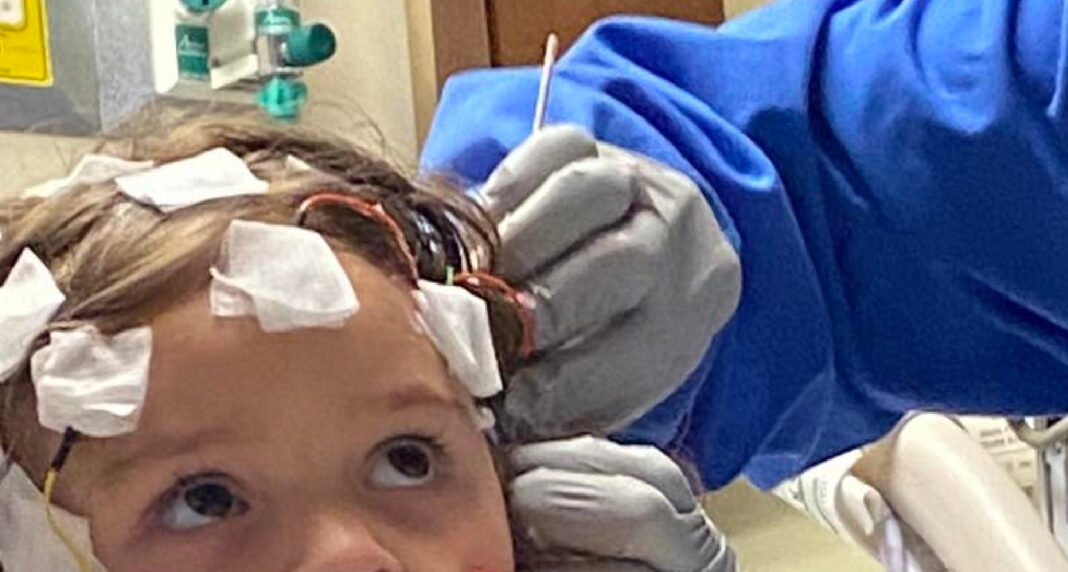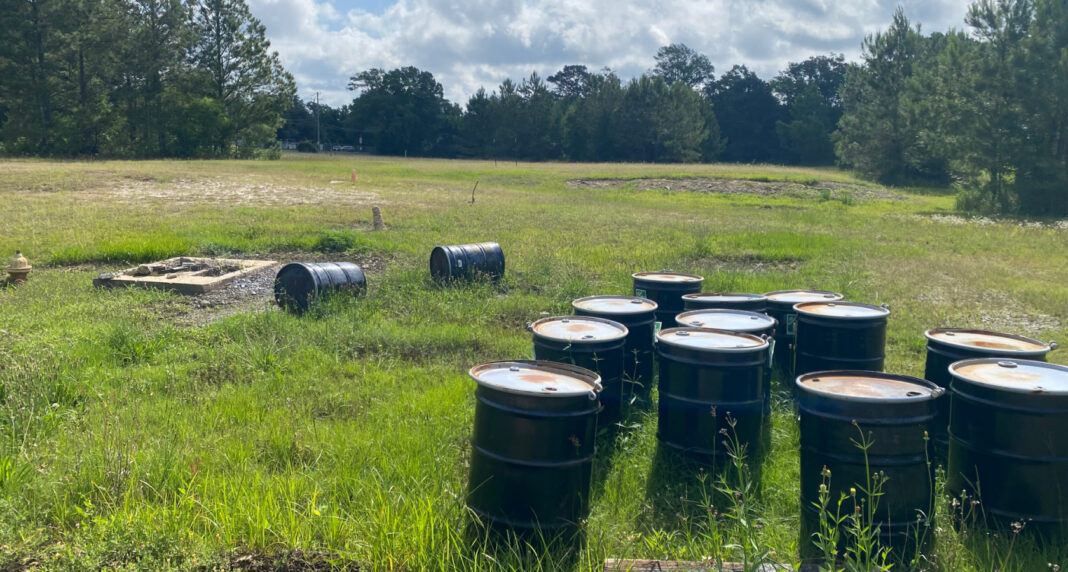How many others living or playing near the toxic plume were misdiagnosed with ADHD, epilepsy, behavioral disorders, autism, or mood conditions?
OCEAN SPRINGS, MS – When a perfectly healthy 2 year old girl from Ocean Springs began slurring her words, losing balance, and showing signs of confusion, her mother and father had no idea what they were facing.
Then came the seizures – long grand mal seizures that had to be stopped with medical intervention.
Within days, the little girl was undergoing a spinal tap and being diagnosed with anti-NMDA receptor encephalitis — a rare and terrifying autoimmune brain disorder in which the body attacks its own brain. Most parents only learn about this condition when their child is on life support.
This little girl was fortunate. Her parents refused to accept a brush off diagnosis of epilepsy. They did the research and demanded more testing. Their persistence paid off. Doctors eventually caught it early enough, and she began a five-day IVIG treatment regimen. The girl celebrated her third birthday hooked to tubes and monitors.
On the third day of treatment – a week after having gone fully non-verbal – she woke up from a nap and said, “My head feels so good.” It was a bittersweet moment. Mom and dad celebrated the fact she was feeling better, but then the haunting notion of what she must have been enduring, and for how long, sank in.
I know this feeling all too well – because that little girl is my daughter.
While she did have a rapid recovery after treatment, the question that haunts me as both her father and an investigative journalist is: what triggered it?
My baby girl had no tumor, no serious infection, no family history of autoimmune disease – the most common factors of the ailment.
But one fact stands out — she spent nearly every weekday at the YMCA Child Watch Center on Government Street in Ocean Springs. That daycare facility sits in close proximity a federally registered toxic waste site.
A Toxic Plume Next to a Daycare
Once home to Ferson Optical Company and now owned by Leica Microsystems, the property sits next to the YMCA – and it’s contaminated with three dangerous chemicals:
- Trichloroethylene (TCE) – a known carcinogen and neurotoxin
- Dichloroethylene (DCE) – a toxic breakdown product of TCE
- Vinyl Chloride – a cancer-causing chemical that also damages the nervous system
These toxins have been leaking into the groundwater for years. A monitoring well just across the street from the daycare — labeled T-CAMW-31 — currently shows concentrations at:
- TCE: 1,200 ppb (safe limit is 5 ppb)
- DCE: 27,000 ppb (safe limit is 70 ppb)
- Vinyl Chloride: 4,000 ppb (safe limit is 2 ppb)
Despite over a decade of attempted cleanup, the numbers remain shockingly high.
The State’s Response: ‘It’s Safe‘
According to a March 2024 fact sheet from the Mississippi Department of Environmental Quality (MDEQ), the site “does not currently pose a risk to human health.” Their conclusion is based on two rounds of outdoor air and soil gas testing conducted in 2021. MDEQ believes that a 10-foot clay barrier underground prevents vapors from reaching the daycare building.
But here’s what they don’t mention:
- No testing has been done inside the YMCA daycare.
- The data they rely on is now three years old.
- The plume of contamination is still active — and still just across the street.
As a father, I have to ask: how can you declare a site safe for children without ever testing the air they actually breathe inside the building?
Medical Science Supports Concern
Doctors don’t know exactly what causes anti-NMDA receptor encephalitis, but research shows it can be triggered by infections, tumors, or environmental toxins that disrupt the immune system.
Several peer-reviewed studies have specifically linked TCE exposure to:
- Autoimmune brain inflammation
- Disruption of the blood-brain barrier
- Production of brain-targeting autoantibodies
A 2012 study in Environmental Health Perspectives found that TCE exposure led to the development of autoantibodies against brain tissue in mice. Other studies have shown that TCE can initiate the very kinds of immune responses that mirror our daughter’s condition.
Others May Be Affected, But Don’t Know It
Anti-NMDA receptor encephalitis is not just rare — it’s frequently misdiagnosed, especially in children. The condition can begin with subtle mood changes, memory issues, or behavior shifts. In its early stages, it often mimics psychosis, epilepsy, bipolar disorder, autism, or even drug-induced behavior. Some patients are placed on psychiatric holds. Others are treated for viral encephalitis or seizure disorders without ever identifying the real cause.
A well-known example is Susannah Cahalan, whose story was chronicled in the bestselling memoir Brain on Fire and later adapted into a Netflix film. Cahalan, a young journalist, was initially misdiagnosed with a psychiatric disorder and nearly institutionalized, before a neurologist discovered she had anti-NMDA receptor encephalitis. Her case helped bring national attention to a disease that often hides in plain sight.
A 2011 study published in The Lancet Neurology found that in many cases, especially in children, anti-NMDA receptor encephalitis is only correctly diagnosed after extensive missteps — if it’s diagnosed at all. Many patients are treated only for the symptoms they present with: seizures, hallucinations, or psychosis. But unless a spinal tap is performed and antibodies are tested, the root illness may remain undiscovered.
If my daughter’s case hadn’t been caught early and diagnosed accurately, we might never have linked it to anything — let alone questioned the safety of her environment.
How many other children living or playing near the Leica plume were misdiagnosed with ADHD, epilepsy, behavioral disorders, autism, or mood conditions — when their symptoms may have stemmed from immune-triggered brain inflammation?
How many cases were written off as psychological, when they were actually environmental?
Without widespread awareness of this disease, and without environmental testing that includes the daycare interior, other families may never even think to question whether a toxic exposure played a role in their child’s condition. That’s what makes this so dangerous.
And Then There’s the Building Itself
On the other side of the property (and even closer to the toxic plume), sits the YMCA daycare facility, which was not always a daycare. It was once a funeral home — a place where chemicals like formaldehyde, phenol, and methanol were likely used regularly in the embalming process. These are known neurotoxins and immune system disruptors.
To this day, we have found no public record that the property was ever tested or remediated before it was repurposed to care for children.
Other States Would Have Flagged This
Mississippi has no law preventing a daycare from operating on the former site of a funeral parlor. But other states do things differently.
In California, New Jersey, and Massachusetts, child care licensing often requires environmental assessments if a property was previously used for commercial or industrial purposes — especially one involving embalming fluids or hazardous solvents. New York and California may require both Phase I and Phase II environmental site assessments before allowing child care centers to operate on such land.
Some states even require vapor intrusion barriers or prohibit ground-floor occupancy entirely if contamination remains. In Mississippi, that level of caution doesn’t seem to apply — or at least not in this case.
We have not yet been able to find any public record showing that the YMCA property was ever flagged for its history as a funeral home. If that history wasn’t disclosed during licensing, then the safety evaluation may have been flawed from the start.
My Family Deserves Answers — So Do Others
MDEQ uses a formula called risk-based remediation, which boils down to this: if they don’t believe people are being exposed, they assume the risk is low — even if highly toxic chemicals are still present in large amounts.
But that assumption isn’t good enough when it’s our children on the other side of the chain-link fence. It certainly isn’t good enough when my daughter has been hospitalized with a brain disease that medical science increasingly links to environmental toxins like the ones sitting 100 feet from her daycare.
And the City of Ocean Springs doesn’t have to wait on the state. It has the authority to act now.
City officials can:
- Pass an ordinance prohibiting any new development on the Leica property until it is actually cleaned up — not just covered up.
- Order independent air and soil testing at daycares, playgrounds, and recreational areas near the plume.
- Require environmental assessments before allowing construction of planned play areas or parks in nearby zones.
If this city claims to care about children and families, it should prove it — not with talking points, but with immediate action.
My daughter is recovering. She’s tough — like her mom and dad. But I will not stop asking questions until the people responsible for protecting our children do more than guess. I want full transparency. I want updated testing. I want someone to say, without hesitation or model-based qualifiers, that the air inside the child care and daycare buildings have been tested and proven safe.
Because we trusted them to protect her. And I’m not sure they did.
This article is based on publicly available data, medical research, and personal experience. No conclusions should be drawn about legal liability without further investigation.



SMH……. I would not trust MDEQ to tell me anything. What Ocean Springs needs is an unbiased third party outside this state to come in and assess that whole mess. And it needs to be cleaned up, it should have been done a long time ago.